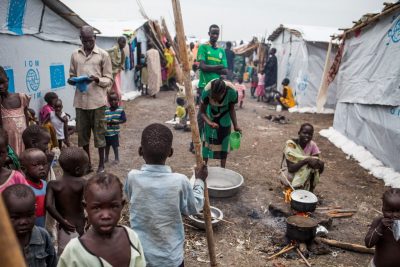By
Peter Louis
Living conditions for new arrivals at the UN protection of civilians (PoC) site in Malakal, Upper Nile State, South Sudan, have improved since a ten day influx of 11,000 internally displaced persons (IDPs) in early August. However, the site remains congested due to space constraints.
The influx of IDPs fleeing food-insecure areas brought the population sheltering at the PoC site, designed for 18,000 people, to over 45,500, including 6,000 who arrived in July. Space limitations forced many new arrivals to shelter along access roads and near drainage in very poor conditions.
Within 10 days of the August influx, the International Organistaion for Migration (IOM) had levelled and prepared land and drainage infrastructure in a 36,000 square metre contingency area to enable construction of shelters and other facilities for new arrivals. IOM worked in close coordination with the UN Mission in South Sudan (UNMISS) and camp manager from the Danish Refugee Council (DRC) to develop the site.
The DRC constructed 129 communal shelters and today, approximately 7,200 new arrivals are sheltering in the improved area. “The quick response highlights the effectiveness of humanitarian coordination and contingency planning, as we were able to rapidly respond with materials already stored on site” explained an IOM Logistics Officer.
As the increased population stretched existing water supplies, IOM also installed three new water points and tanks to supply 120,000 litres of clean, treating water daily to the IDPs in the contingency area. In addition to this the organisation constructed 202 new latrines as well as 80 latrines in a second contingency area under construction.
Although the influx dropped off in mid-August, IDPs continue to arrive, particularly from nearby Wau Shilluk, where access for humanitarians has been difficult for several months.
Earlier this week, IOM recorded 216 new arrivals in one day, including an 18-year-old mother along with her 13-day-old baby and an elderly relative. They each paid 30 South Sudanese Pounds (approximately USD 2–3) to cross the White Nile River to reach Malakal. The mother said they left Wau Shilluk because food supplies had run out and she worried about the health of her baby.
On arrival agencies provide IDPs with immediate assistance, including oral cholera vaccines, soap and water containers. They are also screened for malnutrition.
IOM is working with UNMISS and camp management to develop a second contingency area to provide additional space and mitigate the impact of another population influx.
Since the crisis erupted in South Sudan in December 2013, conflict and food insecurity have displaced more than 2.27 million people, including 632,000 who have fled to neighbouring countries and approximately 1.64 million others who remain internally displaced. Millions more are in urgent need of humanitarian assistance.



No Comments Yet!
You can be first to comment this post!